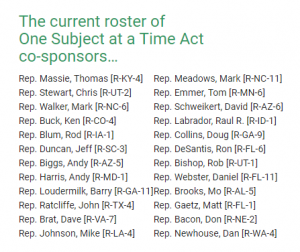What’s the value of additional co-sponsors for the One Subject at a Time Act? RETWEET
Our last Plans & Progress message… 
- Reported that Representative Mia Love has recruited a whopping 24 co-sponsors for the “One Subject at a Time Act” (H.R. 395).
- Promised to tell you how we’ll get new co-sponsors
This Plans & Progress message fulfills that promise. Here’s the crucial thing you need to know to understand our strategy…
Congressional leaders have different incentives from rank-and-file members
- Rank-and-file members don’t want to vote on clustered bills, so they will tend to like OSTA.
- Congressional leaders use clustered bills to pass unpopular measures, so they will tend to dislike OSTA.
This means…
- Congressional leaders will probably block the traditional path to passing a bill.
- Mia Love may have to use a nontraditional method to pass OSTA.
The traditional path involves committee hearings. The nontraditional path involves something called a discharge petition. A discharge petition allows a Congressional majority to demand a vote on a given bill, whether the leadership wants it or not.
Both paths benefit from having a large number of co-sponsors
- The more co-sponsors OSTA has the more pressure there will be for committee hearings
- And having majority support for OSTA is absolutely necessary for a discharge petition
We’re aiming for majority support to enable a discharge petition.
A majority usually equals 218, though the number can dip lower when there are vacant seats. So how can we get from 24 co-sponsors to 218?
The “Social Proof” Strategy
Most people are followers. Politicians are people too. So…
- The more people clamor for OSTA
- The more new co-sponsors OSTA gets
- The easier it will be for the next rep to sponsor too
This helps define the value of each new co-sponsor…
Each new sponsor brings us closer to the next sponsor.
OSTA’s history demonstrates this quite clearly!
OSTA has been reintroduced in the House across several sessions and has gained more co-sponsors each time. New co-sponsors beget new co-sponsors.
So how do we get the next new co-sponsor and the one after that? We’ll use four tactics…
- Messages to Congress — these get counted and serve as Social Confirmation that OSTA is popular
- Phone calls to Congress — this is even more powerful. You may not like to make phone calls yourself, but you will surely want to encourage more extroverted DC Downsizers to do so. We’ll reveal our plans for this tactic in an upcoming Plans & Progress message.
- Group meetings with local Congressional offices — this is another tactic for our more extroverted DC Downsizers and will begin shortly after we launch our phone calls.
- Advertising in targeted districts — This will come last, as we close in on majority support.
Our next plans & progress message will unveil the next tactic we’ll deploy to execute this strategy. Make sure to watch for that message, open it, and read it. In the meantime…
If you haven’t yet asked your reps to co-sponsor HR 395 – the One Subject at a Time Act this week, please do so now.
Thank you for being an active DC Downsizer.
Jim Babka & Perry Willis
Downsize DC


